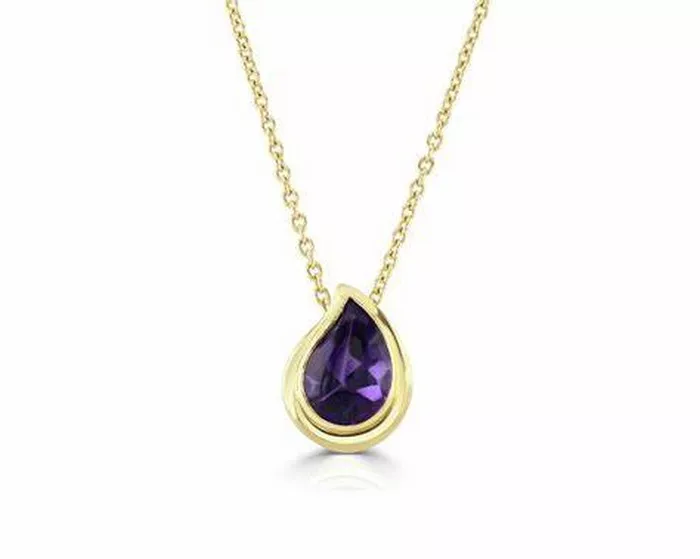Amethyst, with its mesmerizing violet hue, has long been treasured as a gemstone imbued with mystique and allure. Whether adorning royalty in ancient civilizations or gracing contemporary jewelry collections, this captivating crystal continues to captivate enthusiasts worldwide. However, amidst the vast array of amethyst necklaces available, distinguishing genuine specimens from imitations can be a daunting task. Fear not, as this definitive guide will equip you with the knowledge and techniques necessary to discern the authenticity of an amethyst necklace with confidence.
Understanding Amethyst: Origins and Characteristics
Before delving into the intricacies of authentication, it is crucial to grasp the fundamental properties of amethyst. A variety of quartz, amethyst derives its distinctive purple coloration from the presence of iron impurities within its crystal lattice. While commonly associated with shades ranging from pale lilac to deep violet, the intensity of color can vary significantly depending on factors such as geological conditions and exposure to radiation.
Brazil stands as the foremost producer of amethyst, yielding specimens renowned for their rich color and clarity. Other notable sources include Uruguay, Zambia, and Russia, each contributing unique variations in hue and quality. Genuine amethyst exhibits a crystalline structure, often featuring facets that catch and refract light, enhancing its inherent beauty.
The Telltale Signs of Authenticity
1. Color Consistency: Authentic amethyst displays a uniform color distribution throughout the gemstone. Beware of specimens with unnatural color zoning or abrupt transitions between hues, as these may indicate synthetic or dyed alternatives. Genuine amethyst typically exhibits a range of purple shades, from pale lavender to deep violet, with no abrupt shifts in color intensity.
2. Clarity and Transparency: Inspect the clarity of the gemstone by holding it up to light. Authentic amethyst should possess a degree of transparency, allowing light to penetrate the crystal and reveal internal structures. While minor inclusions are common and may indicate natural formation, excessive cloudiness or opaque patches could signal synthetic or inferior quality material.
3. Crystal Structure: Examine the surface of the amethyst under magnification to discern its crystal structure. Genuine amethyst typically features facets and natural formations consistent with its quartz composition. Look for telltale signs of artificial manipulation, such as overly smooth surfaces or uniform patterns devoid of natural irregularities.
4. Weight and Density: Authentic amethyst possesses a specific gravity ranging from 2.65 to 2.80, making it denser than many common imitations. While weight alone cannot confirm authenticity, a noticeably lightweight necklace may warrant further scrutiny. Compare the weight of the necklace to known samples of genuine amethyst to gauge its relative density accurately.
5. Temperature Sensitivity: Genuine gemstones, including amethyst, often exhibit unique thermal properties that can aid in authentication. Place the necklace against your skin to assess its temperature. Authentic amethyst tends to feel cool to the touch initially, warming gradually in response to body heat. Synthetic or glass imitations may feel uniformly cold or warm, lacking the nuanced thermal behavior of natural gemstones.
6. UV Fluorescence: Utilize a blacklight or UV lamp to examine the necklace for fluorescence, a phenomenon exhibited by many minerals, including amethyst. Genuine amethyst typically fluoresces a faint to moderate purple hue under UV light, a characteristic that can help distinguish it from synthetic alternatives. However, be aware that fluorescence alone is not conclusive proof of authenticity and should be considered in conjunction with other indicators.
Additional Considerations
1. Origin and Certification: When purchasing an amethyst necklace of significant value or rarity, inquire about its provenance and request certification from reputable gemological authorities. Certificates of authenticity provide documented evidence of the gemstone’s origin, quality, and any treatments it may have undergone, offering peace of mind to discerning buyers.
2. Price and Reputation: Exercise caution when confronted with exceptionally low prices or dubious claims of exclusivity. While bargains do exist, excessively discounted amethyst necklaces may be indicative of counterfeit or misrepresented merchandise. Research the reputation of the seller and seek recommendations from trusted sources to ensure a reputable transaction.
3. Consultation with Experts: When in doubt, seek the expertise of qualified gemologists or jewelry appraisers experienced in identifying gemstone authenticity. Professional examination and testing can provide invaluable insights into the composition and quality of the amethyst necklace, guiding you towards an informed decision.
Conclusion
In a marketplace flooded with imitation gemstones, distinguishing genuine amethyst necklaces requires a keen eye and a thorough understanding of the gemstone’s characteristics. By scrutinizing factors such as color consistency, clarity, crystal structure, and thermal properties, you can confidently assess the authenticity of an amethyst necklace. Remember to verify the necklace’s origin, seek certification from reputable authorities, and exercise caution when confronted with suspiciously low prices. Armed with this knowledge, you can embark on your quest for the perfect amethyst necklace with clarity and assurance, secure in the knowledge of its authenticity and inherent beauty.
FAQs
How do I know if my amethyst is expensive?
The price of amethyst depends on factors like clarity, color intensity, and carat weight. Generally, deeper purple hues with minimal inclusions command higher prices. Larger stones and those with exceptional clarity can also be more expensive.
What color is real amethyst?
Real amethyst typically exhibits shades ranging from pale lilac to deep purple. The most prized specimens display a rich, uniform purple color without any visible zoning or color banding.
Why is amethyst so cheap?
Amethyst’s abundance in nature, coupled with advancements in mining technology, has made it relatively affordable. Additionally, synthetic and treated amethysts are commonly available, further driving down prices.
How can you tell if an amethyst is good quality?
High-quality amethysts have a deep, rich purple color with minimal inclusions. They should also exhibit excellent transparency and brilliance when viewed under proper lighting conditions. Professional gemologists assess amethyst quality based on factors like color, clarity, cut, and carat weight.

